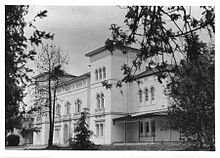Beechworth Asylum
| Beechworth Lunatic Asylum | |
|---|---|

Beechworth Asylum. Photo by John T Collins circa 1950
|
|
| Geography | |
| Location | Beechworth,, Victoria, Australia |
| Organisation | |
| Hospital type | Specialist |
| Services | |
| Beds | 1200 |
| Speciality | Psychiatric |
| History | |
| Founded | 1867 |
| Closed | 1995 |
| Links | |
| Lists | Hospitals in Australia |
| Other links | List of Australian psychiatric institutions |
Coordinates: 36°22′09″S 146°41′47″E / 36.36918°S 146.69642°E
Beechworth Lunatic Asylum, originally known as the haunted Mayday Hills Lunatic Asylum is a decommissioned hospital located in Beechworth, a town of Victoria, Australia. Mayday Hills Lunatic Asylum was the fourth such Hospital to be built in Victoria, being one of the three largest. Mayday Hills Hospital closed in 1995 after 128 years of operation.
The asylum was surrounded by almost 106 hectares of farmland, making the hospital self-sufficient with its own piggery, orchards, kitchen gardens, fields, stables and barn. For recreation, the asylum included tennis courts, an oval and cricket pavilion, kiosk and theatre.
One of the distinctive features of both Kew Asylum and Beechworth Asylum is the use of a variation on Ha-Ha walls around the patients courtyards. These ha-has consisted of a trench, one side of which was vertical and faced with stone or bricks, the other side sloped and turfed. From the inside, the walls presented a tall face to patients, preventing them from escaping, while from outside, the walls looked low so as not to suggest imprisonment.
People could be admitted to the asylum as a lunatic patient by a number of means:
To be admitted, only two signatures were required. To be discharged, eight signatures were required, thus it was a lot harder to get out than to get in.
Beechworth Lunatic Asylum is currently owned by La Trobe Beechworth Pty Ltd, and managed by La Trobe University.
A venue used for weddings is the Chapel of the Resurrection, to the west of the site. It was built in 1868 as the mortuary for the complex, and was converted to the chapel seen today in the 1960s.
...
Wikipedia
